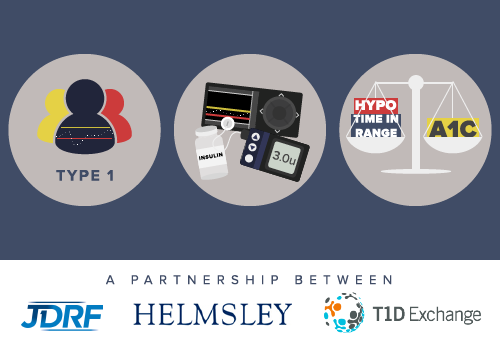JDRF, Helmsley Charitable Trust, and T1D Exchange Partner on Major $5.2 Million Initiative to Improve Outcomes in Type 1 Diabetes
By Adam Brown
 By Ava Runge, Adam Brown, and Alexander Wolf
By Ava Runge, Adam Brown, and Alexander Wolf
How many people have type 1? What are the barriers to using new therapies? What outcomes matter beyond A1c?
JDRF, T1D Exchange, and the Helmsley Charitable Trust recently announced a collaborative health policy initiative to address research gaps, expand access to new therapies, and improve outcomes in type 1 diabetes. JDRF and HCT each contributed $2.6 million to fund the initiative (for a total of $5.2 million), and T1D Exchange will provide strategic guidance, operational support, and insights and perspectives from a broad representation of the T1D population and clinicians treating people with type 1. The initiative comprises three programs – T1D Unmet Needs, Barriers to Adoption, and T1D Outcomes – aimed at advancing type 1 diabetes research, policy, and patient quality of life. Read more on each initiative below; we’ll be on the lookout for results at various points next year.
-
“T1D Unmet Needs” will produce a publicly available, comprehensive source of type 1 diabetes facts and figures, including the number of people with type 1 diabetes in the US, how often ER visits occur for hypoglycemia, and what those visits cost. Completion is expected in late 2017.
Reliable facts and figures are greatly needed in these areas. Today there is no definitive source for how many people are living with type 1 diabetes in the US and estimates have ranged from “1.25 million” to “up to 3 million.” There is also limited data on the burden and associated costs of hypoglycemia. Better data could highlight the real burden and dangers of type 1 diabetes and the critical value of reducing outcomes such as hypoglycemia. These data are especially important for insurance companies, who may be more likely to cover a drug or device that reduces severe hypoglycemic episodes if there are more clearly defined economic benefits.
-
“Barriers to Adoption” will conduct market research to understand what prevents access and adoption of new therapies and technologies. The aim of the program is to generate actionable evidence on barriers to prescribing and using treatments for type 1 diabetes (e.g., CGM, pumps, new insulins), which could inform future product design and health policy. Completion is expected in late 2017.
People with diabetes list many challenges to starting a new technology or therapy. The appendix below is a partial list of some of the top barriers we hear: do you have other insights to offer? Let us know!
-
“T1D Outcomes” will evaluate measures beyond A1c (e.g., time-in-range, hypoglycemia, etc.), which are used to assess and compare potential therapies in research, regulatory, and health plan decision-making. The hope is to standardize these outcomes for research and get buy-in from regulatory decision makers and insurance companies. This program will rely on reviewing the existing scientific literature and surveying people with type 1 diabetes, caregivers, researchers, and healthcare providers. The program’s outcome will be a consensus statement, to be published in early 2017. Efforts are already underway and The diaTribe Foundation has enjoyed taking part in this program so far.
These initiatives are exciting and continue all three organizations’ push beyond research into access, advocacy, and policy. We salute JDRF, T1D Exchange, and the Helmsley Charitable Trust for blazing a trail on these critical areas – research and technology in type 1 has never been more exciting, though the uncertainties around getting patients access to devices have never been greater. This three-pronged initiative has bold goals, and we hope it facilitates better product design, more patient-centric discussions with regulators, expanded insurance coverage, and ultimately, better outcomes!
Appendix: What are some of the patient barriers to using new devices?
-
Cost, lack of insurance coverage;
-
“I don’t want something on my body,” “I don’t want something in my pocket,” more stuff to deal with and carry around;
-
“I don’t want my diabetes to be more visible,” constant reminder of my diabetes (e.g., CGM gives alarms);
-
Basic awareness that products like CGM, pumps, and new insulins are even available;
-
Hassle factor, cost-benefit analysis: products don’t offer enough perceived benefits relative to the additional perceived costs of using them (e.g., CGM still requires fingerstick calibrations);
-
“I already have a routine that works” (i.e., resistance to change from existing diabetes management strategy);
-
Poor experience with early generation devices (e.g., early CGM was not accurate or reliable);
-
Short-term psychological focus, lack of diabetes motivation (i.e., diabetes requires making short-term sacrifices to benefit in the long run);
-
“I don’t trust machines”;
-
Devices typically give negative feedback (“You are HIGH”), with no focus on positive feedback (“You spent 86% of your day in range. Nice job!”); and
-
Historical lack of cool, consumer-friendly design (though this is changing).
[Editor's Note: Disclosure - diaTribe is sponsored in part by a generous grant from the Helmsley Charitable Trust.]







